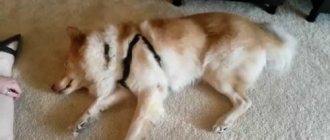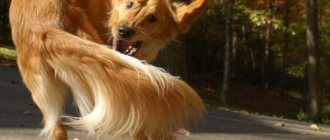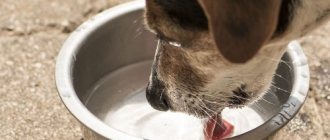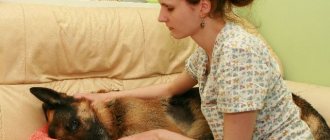Today I will talk about why some dogs may experience back leg failure. I will consider possible pathological processes, their causes, how they manifest themselves and which breeds are predisposed. I’ll tell you what to do and how to cure it with folk remedies if the dog cannot get up and its paws are taken away. This will cover the issues of preventing spinal diseases.
Symptoms of Hind Leg Failure in Dogs
You may notice the first signs of a problem while walking. If they appear after sudden movements (for example, during games), then do not consider the activity to be the cause of the disease. Rather, the movement provokes symptoms of an existing problem. Symptoms of hind leg failure in dogs are extremely unpleasant:
- The dog cannot move normally
- Hind legs weaken and become unruly
- As a result, paralysis of the pelvic limbs or paresis may develop.
Manifestations of the disease do not always occur all at once. Sometimes in the morning the dog feels pain, and in the evening the deplorable signs and consequences of paralysis of the limbs are already obvious.
Preventive measures
To ensure that the dog’s hind legs are healthy and do not fail unexpectedly for the owner, preventive measures are carried out:
- Maintain a balanced diet.
- Maintains the pet's normal weight.
- A puppy is fed milk, an adult dachshund is given fermented milk products.
- They walk him on a leash and do not allow him to jump from great heights.
- Protect from stress.
- Avoid meeting other people's dogs.
- Eliminate the possibility of contracting dangerous infections.
- The dachshund gets x-rayed regularly.
- Give your pet chondroprotectors.
Causes and diseases leading to hind leg failure in dogs
The disease can cause discouragement among owners, since everything happens quite abruptly and unexpectedly.
There can be many reasons for it:
- Limb injuries: fractures, nerve damage, tendon ruptures and sprains.
- Arthritis of the extremities
- Tumors
- Spinal pathology
If the spinal cord is affected in the thoracic or lumbar spine, paralysis or paresis may develop. However, injuries are also risk factors. Sometimes a sharp turn, a fall, a blow, a bite during a fight with another individual provokes a whole chain of problems. Keep in mind that the dog may slip on the ice, jump unsuccessfully, or turn around. If possible, monitor your pet to reduce risk factors.
Nervous system
One of the most common causes of hind leg failure in dogs that owners encounter is problems with the nervous system.
Neurological disorders manifest themselves as follows: severe pain occurs in the thoracolumbar spine of the dog. Then the paws are removed, and it is clear that the animal cannot move its limbs. As a result, pain sensitivity disappears. You may notice the first signs of a problem while walking. If they appear after sudden movements (for example, during games), then do not consider the activity to be the cause of the disease. Rather, the movement provokes symptoms of an existing problem.
This problem is typical for small and medium-sized dogs rather than large breeds, as well as individuals with a genetic predisposition to damage to the intervertebral discs. The main risk group is dachshunds; the problem is observed in French bulldogs, Brabançons, Pekingese and other representatives of brachycephalic breeds. Most often, unpleasant changes are observed between the ages of three and eight years.
Some dachshund owners think that the problem lies in the long spine. However, science does not confirm this guess. And it is interesting that the manifestations of the disease do not always appear all at once. Sometimes in the morning the dog feels pain, and in the evening the deplorable signs and consequences of paralysis of the limbs are already obvious.
Injuries
The pathology develops in stages: first, the structure of the spinal column is disrupted at the site of injury, then swelling occurs. This causes the spinal cord and radicular nerves to become compressed. The latter problem leads to the disruption of the flow of blood with oxygen.
When this continues for some time, nerve cells die and nerve impulses along the peripheral nerves are blocked.
A severe injury disrupts the integrity of the spinal cord tissue, in other words, it ruptures it. It is clear that this is critical for any animal, and the help of a specialist is needed.
Degenerative diseases of the spine
Sometimes the spine can simply fall under the influence of degenerative processes. This also leads to the fact that the dog’s hind limbs stop working normally. In this case, metabolic processes in the tissues of the body are disrupted, and the parts of the spinal column undergo pathological changes.
Spondylosis
Your dog's hind legs may also fail due to so-called “local aging,” or spondylosis, of certain areas of the spine. This disease goes away quite slowly. It may be almost invisible at an early stage. The outer fibers of the annulus fibrosus are damaged first. Then a process called calcification in medicine occurs with the anterior longitudinal ligament. Beak-shaped growths appear on the spine, they are called osteophytes.
Tumors in the spine
Tumor-like processes sometimes occur in the spine and in the spinal cord itself. As a result, pathologies gradually develop, and in some cases, fractures of the spinal column. If the process sharply worsens, the developing edema compresses the roots and spinal cord. This results in the following symptoms:
- limbs are weakened or compressed,
- the back arches,
- gait is disturbed,
- the dog squeals while trying to make the usual movements,
- refuses food.
Spondyloarthrosis
The joints of the spine are the weak point of a dog diagnosed with osteochondrosis. If they are subjected to static loads, the joints can become deformed. The phenomenon is called spondyloarthrosis. Uneven loads on the spinal column are also dangerous. They lead to a vertebral hernia: due to pathology, the fibrous ring changes, and as a result, the nucleus pulposus of the intervertebral disc protrudes. The hernia compresses the radicular nerves and sometimes the spinal cord itself.
Discopathy
Diseases of the intervertebral discs, also called discopathy, cause neurological damage to the pelvic limbs. The disc substance changes and enters the spinal canal. As a result, it is clamped:
- or the spinal cord itself,
- for the roots of the spinal nerves.
Neurological deficit is a consequence of these processes.
When a large dog's paws fail, the problem has its own characteristics. In Doberman Pinschers, German Shepherds, Great Danes, Rottweilers and similar breeds, the disease progresses gradually over several months or years. It can be assumed that damage to the intervertebral discs has occurred - in the lumbar region or near the lumbosacral junction.
French bulldogs are especially susceptible to discopathy. This is due to their unnatural anatomy, which resulted from artificial selection. The spine of this breed has become elongated, which leads to greater stress on it. The situation is aggravated by the fact that the distance between the vertebrae is greater than normal. As a result, even at rest, an intervertebral disc can fall out, and even more so during active movement.
Dysplasia
Heavy breeds have their own problem - diseases of the musculoskeletal system. Saint Bernards, Shepherd Dogs, Labrador Retrievers, and Great Danes are characterized by rapid growth at the age of 4-10 months. This is partly why puppies of these breeds suffer from hip dysplasia.
Pay attention to the first symptoms! If a dog limps after sleep or a passive state in a lying position, and then “paces” during the day, these are the first signs, after which it is advisable to call the veterinarian home or take the dog for an x-ray. If the dog is not treated, the symptoms may intensify, and a prolonged problem can lead to the animal completely refusing to walk.
Osteocondritis of the spine
The most severe form of damage is spinal osteochondrosis.
In this case, discopathy takes on a more dangerous form - degenerative processes move from the intervertebral discs to the surrounding vertebral bodies. The ligaments and intervertebral joints are also affected. Here are some common causes of osteochondrosis:
- Genetic developmental defects. Because of this, the vertebrae function unstable.
- Spinal injuries.
- Autoimmune processes.
- Rheumatoid lesions.
- Microcirculation is disrupted, and as a result, the nutrition of the disc is disrupted.
Spinal pathology
Blows and bites, falls and unsuccessful jumps, as well as other unfavorable factors lead to spinal pathology. This phenomenon leads to paresis and paralysis. The spinal column ceases to be integral, its structure is disrupted and swelling occurs. The spinal cord and radicular nerves are compressed.
Localization
Paresis varies according to the location of the problem area and the degree of damage to the vertebrae.
In addition to spinal diseases, the causes of paresis can be:
- Infectious diseases (distemper, rabies).
- Hemorrhages of the brain or spinal cord.
- Meningitis.
- Encephalitis.
- Injuries of the spine and limbs.
- Intoxication of the body with chemicals.
- Tumor development.
- Polyneuropathy of allergic origin.
- The process of giving birth in bitches can result in partial paralysis of the hind limbs. This occurs due to a lack of calcium in the body.
The cause of paresis may be distemper.
What to do if your dog's back legs fail?
Unless you have special skills, knowledge and experience, you will most likely need a veterinarian. A doctor whose specialty is neurology will be especially helpful.
Now let's look at common questions.
Is it worth contacting if the first symptoms just appear: pain reactions to body movement, tension in gait or refusal of physical activity?
Yes, it's worth it. The sooner you contact, the greater the chances of helping. Even if the alarm is false, you can take the opportunity to do a preventive examination.
If the late stage has already begun - the hind legs have given up, is it worth calling the veterinarian, or is the dog already doomed?
There are always chances. If the animal is dear to you, then try to find out what can be done in the current situation. Even completely immobilized dogs were sometimes brought to their feet. Another thing is that the chances in this case are less.
Practical advice for a critical situation:
- If the dog is injured and, apparently, the spine has been damaged, then in order to take it to the veterinary clinic, secure it to the board with belts or bandages.
- If your four-legged friend is whining and howling, and the doctor will arrive soon, do not rush to use painkillers - it may contribute to further displacement of the vertebrae.
A common mistake. In part, the symptoms of hind leg failure in a dog may coincide with the symptoms of sciatica. As a result, instead of immobilization, massage is done, which at a minimum wastes valuable time. It is also worth knowing that this problem cannot be treated independently at home.
How to help your pet
It is very important not to self-medicate so as not to aggravate the problem. If a paw is broken, the pelvic bones or spine are damaged, urgent surgery may be needed, so delaying is very dangerous for the dog. “Human” drugs can also cause serious harm, especially to small individuals, due to the large dosage. If a large breed dog needs treatment for arthrosis of the hip joint, massage and thermal treatments are also contraindicated for it and can be harmful.
Do not give your dog pain medication before visiting the veterinarian, so as not to distort the picture of the disease.
It is necessary to take the animal to the doctor in an immobilized state. Otherwise, the dog may cause broken bones to dislodge, damage nerves or blood vessels, which will lead to bleeding. The veterinarian will take an x-ray or ultrasound, perform other diagnostic procedures and prescribe treatment.
If your dog doesn't have problems with his hind legs, do exercises to improve his coordination. They will help your pet to better control the rear part of the body:
What does a veterinarian do if a dog's hind legs fail?
The veterinarian's procedure will be something like this:
- 1. Examination and assessment of the dog’s condition, diagnosis.
- 2. Checking the tactile and pain sensitivity of the limb.
- 3. Checking reflexes.
- 4. Checking for pain in the spine area.
- 5. Purpose of an x-ray examination.
In some cases, myelography is also needed: a radiopaque substance is injected into the spinal canal, thanks to which even the slightest abnormalities will be revealed in the image.
Thanks to this, the process will be as targeted as possible. Blood and urine tests are also sometimes prescribed. This is done because sometimes concomitant pathologies arise: in the kidneys, heart, liver, and so on. The tests will allow the veterinarian to make an accurate diagnosis, make the right treatment decisions and determine the course of action. When this is not essential for the health of the animal, the owner himself can choose the method of treatment, but in some cases the doctor may insist on a more effective option for your situation.
| Calling a veterinarian to your home | For free |
Recovery period from paresis
The recovery period is a complex process that involves, first of all, exercises that will allow the pet to at least move its limbs with partial compression and release of its paws. However, this does not mean at all that it is time to start running. The process of even walking after paralysis in dogs will require a lot of patience and physical effort.
Daily short-term training for 5-15 minutes, limited by the dog’s ability. At the same time, it is worth strengthening the dog’s diet by diversifying it with calcium. Recovery also involves moral support: please the dog with a loyal attitude, stroke its belly, play with it to the best of its ability. It is important to understand that learning to walk again is not so easy, and you are the only chance for this.
Based on practice, rehabilitation of psychomotor functions (the ability to walk) occurs quickly, however, first you should support a pet that will stumble and refuse to walk. Of course, when your pet weighs 30 kg or more, you have a certain risk of “straining yourself” during regular training with your four-legged dog.
As specialized equipment for dog sports equipment, you can use a dog carrier or cart. Such a cart is based on the size of the dog itself, so that he can work independently with his paws. Regarding special devices for dogs during the rehabilitation period, little can be said. An ordinary pet store does not sell such goods, due to problems with choosing the volume of the device itself, as well as high prices.
In this case, you can use your wits and try to solve the problem yourself, say, using a standard sports bag from the store and scissors. How? Using scissors, we cut everything to the shape, leaving the sides, handles and fasteners from the bag, if necessary, add elastic bands. That's it, the carrier is ready.
Diagnostics
Only an experienced veterinarian can diagnose the disease. The dog is examined at the clinic and a number of necessary procedures are performed:
- tests;
- X-ray of the spine;
- Ultrasound.
The dog owner must remember all the points that could influence the occurrence of the disease. For example, insect bites, heavy physical activity, after which the dog could land unsuccessfully.
After all the analyzes and tests, the veterinarian will prescribe the appropriate treatment, which can only be done with medications, or in serious cases, with surgery.
Stages of neurological disorder
Depending on how the dog’s disease progresses, treatment is prescribed. Paresis has several stages, and veterinarians rate it using a six-point system.
Outpatient
Outpatient paresis begins with the third stage of the disease:
- sensitivity is preserved in the hind limbs;
- walking is difficult;
- The dog is on its feet, but not stable.
Late
Non-ambulatory paresis begins with the fourth stage of the disease. Its signs are as follows:
- sensitivity decreases;
- the body reacts to severe pain upon palpation;
- the animal cannot stand or walk.
At the fifth and sixth stages of paresis, the dog may no longer respond to pain.
In medicine, ambulatory paresis is called partial, that is, she can move, although not fully. With non-ambulatory paresis, that is, complete, there is no control over movements. The animal moves with difficulty, dragging the rear part of its body behind it.
If with ambulatory paresis you can get by with light therapeutic intervention, then in the last stage of non-ambulatory paresis only surgery can help.
Other organs
You should know and remember that paresis can not only be visible from the outside. Internal organs may also suffer.
Bladder
Paresis of the bladder and other internal organs occurs in dogs. This is due to the presence of a malignant tumor in the body. As it grows, it compresses tissues, which begin to atrophy over time. After this, paresis occurs.
Even if the tumor is small, but its pressure on the internal organs is prolonged, the nervous tissue still begins to lose its functions.
Intestines
The cause may be not only a tumor, but also parasites. The larvae spread throughout the dog's body in the blood and settle in the tissues. The encapsulation process begins, which triggers an effect similar to that of a tumor. It is very scary when intestinal paresis occurs. The animal loses the ability to defecate.
Facial nerve
Infectious diseases can cause facial paresis in dogs. The virus enters the nervous tissue, triggers the inflammatory process and the nervous tissue loses the ability to conduct full impulses.











